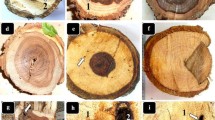Abstract
The rot ofChamaecyparis obtusa (hinoki) trees was studied in the northern part of Kagawa Prefecture, Japan. Among 158 hinoki examined, butt rot was found in 28.6, 58.3, and 100% of trees in the 29, 30, and 34-year-old stands, respectively. All trees with butt rot, and 11 trees without it had rotted roots. Thirteen hinoki were peeled byCervus nippon (sika deer) and all of them were infected with butt rot. The maximum height of rot in deer-damaged trees was 2.6 m from the ground level, but was 1.9 m in undamaged trees. About eighty-two percent of rotted trees showed rotted areas of less than 40 cm2 on the cross section of stems at the ground level. White mycelia and black flecks sometimes appeared in the rotted wood. Basidiocarps of polyporaceous fungus were often found on felled logs and rotted stumps of hinoki and identified asPerenniporia subacida. Basidiomycetous fungus was isolated frequently from rotted wood of roots and stems, and determined to beP. subacida by comparative study on cultural characteristics. An inoculation experiment and wood-decay test proved that the fungus was the cause of the rot of hinoki. Few absorbing roots of living trees were found in the clayey subsurface soil of the high dry bulk density and the less soil aeration. Some absorbing roots had root rot and the rot spread from the base of the absorbing root to the central part of the woody root. This is the first report on the rot of hinoki caused byP. subacida in Japan.
Similar content being viewed by others
Literature cited
Allen, E.A., Morrison, D.J., and Wallis, G.W. (1996) Common tree diseases of British Columbia. 178pp, Canadian Forest Service, Victoria.
Aoshima, K. (1950) Wood-rottingPoria from Japan (I). Bull. Gov. For. Exp. Sta. 46: 155–168. (in Japanese with English summary)
Aoshima, K., Furukawa, H., and Hayashi, Y. (1964) Fungi observed in decayed wood of living trees ofCryptomeria japonica. 75 th Mtg. Jpn. For. Soc.: 397–398. (in Japanese)
Bondartsev, A.S. (1971) The Polyporaceae of the European USSR and Caucasia. 896pp, Israel Program for Scientific Translations Ltd., Jerusalem. (translated from Russian)
Buckland, D.C. (1946) Investigation of decay in western red cedar in British Columbia. Can. J. Res. Sec. C. 24: 158–181.
Dai, Y.C. and Xu, M.Q. (1998) A new root and butt rot disease on coniferous trees in Changbai Mts., northeastern China. Fungal Sci. 13: 29–34.
Forest Soil Division (1976) Classification of forest soil in Japan (1975). Bull. Gov. For. Exp. Stn. Tokyo 280: 1–28.
Foster, R.E. and Wallis, G.W. (1974) Common tree diseases of British Columbia. Dept. Environ. Can. For. Serv. Publ. 1245: 1–116.
Gilbertson, R.L. and Ryvarden, L. (1987) North American Polypores. Vol. 2. 885pp, Fungiflora, Oslo.
Hansen, E.M. and Lewis, K.L. (1997) Compendium of conifer diseases. 101pp, APS Press, St. Paul.
Katsu, Z. (1971) Butt rot ofChamaecyparis obtusa. Forest Pests 20: 141–146. (in Japanese)
Kawabe, Y., Hashimoto, H., Dozono, Y., Matsuo, T., and Miyazaki, T. (1983) Butt rot ofChamaecyparis obtusa in Nagasaki Prefecture. Trans. Kyushu Br. Jpn. For. Soc. 36: 231–232. (in Japanese)
Kobayashi, T., Katsumoto, K., Abiko, K., Abe, Y., and Kakishima, M. ed. (1992) Illustrated genera of plant pathogenic fungi in Japan. 685pp, Zen-no-kyo, Tokyo. (in Japanese)
Kubayashi, T. (2000) Development of butt rot in the trunks of hinoki cypress (Chamaecyparis obtusa) at the foot of Mt. Unzen, Nagasaki Prefecture. J. Tree Health 4: 9–18. (in Japanese with English summary)
Kubayashi, T. and Maekawa, N. (2001) Identification and pathogenicity of the fungus isolated from butt rot of Japanese cypress,Chamaecyparis obtusa. J. Gen. Plant Pathol. 67: 262–267.
McCallum, A.W. (1928) Studies in forest pathology. I. Decay in balsam fir (Abies balsamea Mill.). Can. Dept. Agric. Bull. (n.s.) 104: 1–25.
Ogawa, S. and Goto, S. (1998) The occurrence state of butt rot disease of hinoki in Fukuoka Prefecture. Trans. Kyushu Br. Jpn. For. Soc. 51: 83–84. (in Japanese)
Ryvarden, L. and Gilbertson, R.L. (1994) European Polypores. Part 2: Meripilus-Tyromyces. Synopsis Fungorum 7: 395–743.
Stalpers, J.A. (1978) Identification of wood-inhibiting Aphyllophorales in pure culture. Stud. Mycol. 16: 1–248.
Whitney, R.D. (1995) Root-rotting fungi in white spruce, black spruce, balsam fir in northern Ontario. Can. J. For. Res. 25: 1209–1230.
Zhao, J.D. (1998) Flora Fungorum Sinicorum. Vol. 3. Polyporaceae. 456pp, Science Press, Beijing. (in Chinese)
Author information
Authors and Affiliations
Corresponding author
About this article
Cite this article
Tabata, M., Kato, T., Ohkubo, M. et al. Butt rot ofChamaecyparis obtusa (Sieb. et Zucc.) Endlicher trees caused byPerenniporia subacida in Shikoku district, Japan: Pathogen, distribution of damaged trees in the stand, and soil investigation. J For Res 7, 105–112 (2002). https://doi.org/10.1007/BF02762515
Received:
Accepted:
Issue Date:
DOI: https://doi.org/10.1007/BF02762515




